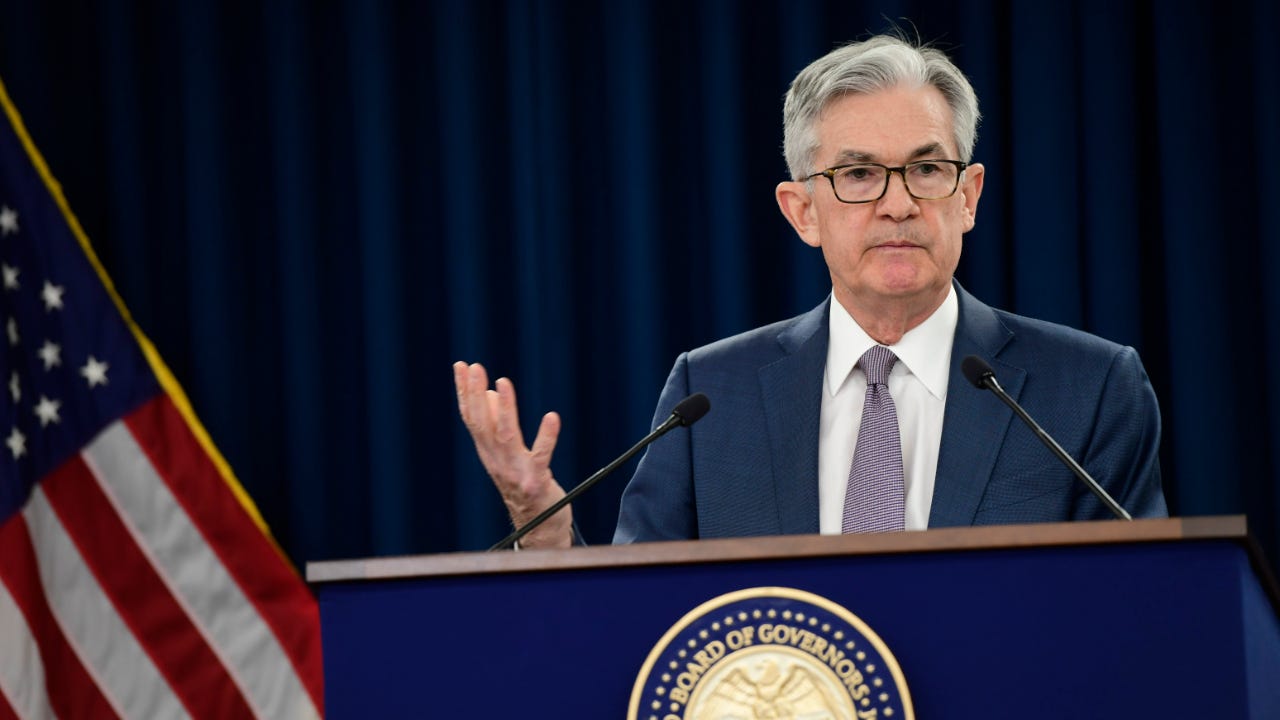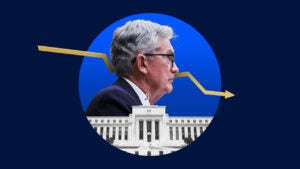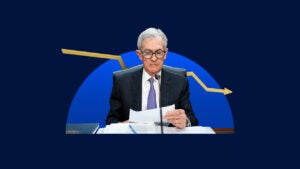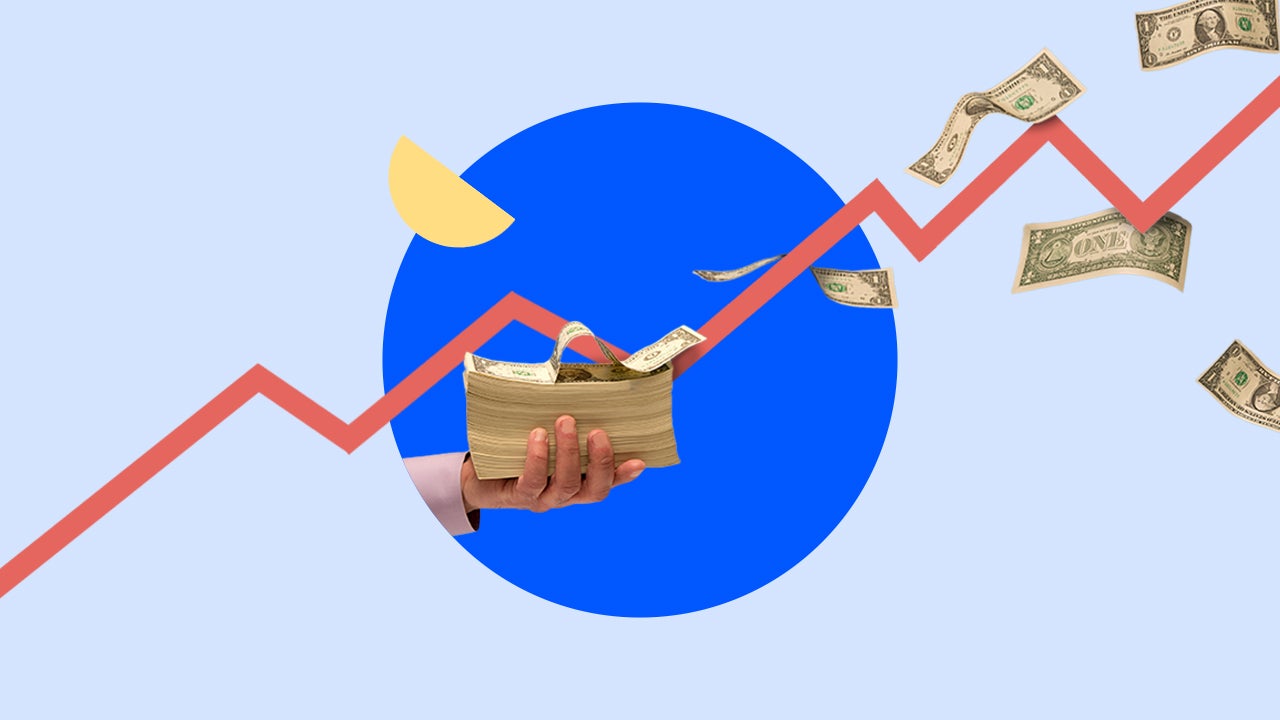Fed decision: Interest rates held steady, sees rates at zero through at least 2023

The Federal Reserve held interest rates steady Wednesday and indicated plans to keep them there for at least three more years in a bid to keep throwing out all of the stops against the coronavirus crisis as the U.S. economy works on a comeback.
As expected, the Fed’s policymaking board decided to keep its overnight lending rate anchored at near-zero percent, as low as officials want it to go. Officials adjust that benchmark rate, which is currently in a target range of 0-0.25 percent, when the financial system needs stimulating or stabilizing. Consumers know it best as the main lever that influences how much they pay to borrow and how much they’re paid to save.
Along with keeping interest rates low, members of the Federal Open Market Committee (FOMC) updated their closely tracked “dot plot,” which shows where officials expect rates to be years from now. As was universally foreseen, U.S. central bankers are expecting to keep rates at their historic lows through 2023, as far out as the communication tool goes.
U.S. central bankers also provided more concrete communication about what officials would like to see before adjusting rates, often called forward guidance. The Fed provided a three-part test for what it will be looking for.
In the Fed’s post-meeting statement, the FOMC said it “expects it will be appropriate to maintain this target range until labor market conditions have reached levels consistent with the committee’s assessments of maximum employment and inflation has risen to 2 percent and is on track to moderately exceed 2 percent for some time,” officials wrote in their post-meeting statement, released at 2 p.m. in Washington.
Officials also judge that the economy will need accommodative measures from the Fed until inflation “averages” at 2 percent over time and consumers’ expectations about where price pressures will be in the future remain “well anchored” at 2 percent, strengthening the Fed’s new plan to tolerate higher levels of inflation for a more robust labor market.
“This is a committee that is both confident and committed and determined to reach our goals,” Chairman Jerome Powell said in a post-meeting press conference. “The idea that we would look for the quickest way out, that’s not who we are.”
Fed’s new zero-rate world
Borrowing costs have been at those rock-bottom levels for six months now, with officials slashing rates to the zero lower bound in the early days of the pandemic at two emergency meetings within 13 days of each other.
The Fed’s September announcement essentially codified officials’ pledge that they are not even “thinking about thinking about” bringing borrowing costs back up anytime soon to give the labor market and financial system time to recover from what Powell has called the worst economic downturn in a lifetime.
For consumers, it means today’s low-rate world will be the status quo for years to come. Savers are likely to keep seeing tepid earnings on money stashed in savings accounts and certificates of deposit (CDs). Borrowers will find that the wind will be in their sails for longer as interest rates on products including credit card rates and home equity lines of credit (HELOCs) trickle lower, with the zero-rate environment the Fed has orchestrated filtering through the rest of the economy.
“Low interest rates are candy for stock market investors and the Fed just set the whole bucket of goodies on the front porch,” says Greg McBride, CFA, Bankrate chief financial analyst. “But savers and retirees have gotten their feet stomped on when the Fed cut rates to zero, and now been kicked in the shin by saying they won’t be in a hurry to corral inflation when it materializes.”
Fed’s promise: Lower-for-longer interest rates
The latest announcement comes nearly three weeks after the Fed made a significant change to the way it’s planning to guide the U.S. economy back to its twin goals of low and stable prices and maximum employment. Powell in August announced that the Fed was no longer planning to lift borrowing costs on low unemployment alone, with the knowledge after a years-long review that it doesn’t always spark runaway inflation.
Instead, officials are going to adopt an “average” inflation target of 2 percent, rather than an outright ceiling. The point is to make sure that inflation sustainably rises to 2 percent and doesn’t fall too low, making up for periods of below-target price pressures by allowing it to run hotter for the same amount of time.
All of that sets the stage for a lower-for-longer rate policy that makes possible the Fed’s plans of keeping rates low for years to come.
“There was very much a tone today to telegraph the point that the Fed is not doing anything,” says Padhraic Garvey, CFA, regional head of research for the US at ING. “What Powell was really saying to reporters and to markets is that we are going to be patient, we are not looking to hike rates, and we are going to maintain a very easy policy for as long as we need to.”
But some Fed watchers are voicing concerns about the Fed’s ability to achieve its new goal, particularly when it struggled to get prices up to 2 percent on a sustainable basis during the previous expansion. Adding to the challenge is communicating about a subject as tricky as inflation.
“When people expect prices to go up, they tend to go out and buy everything right away, and that in turn is a self fulfilling prophecy, which drives prices up,” says John Leer, economist at Morning Consult, describing how inflation expectations work. “It will be extremely important to communicate what they plan on doing, and they have to make sure that market participants and also everyday, average consumers understand what to expect from prices moving forward. They have their work cut out for them.”
The Fed’s September statement made that policy framework change official, but some officials aren’t exactly on the same page when it comes to framing where it’s heading moving forward.
Two policymakers — Dallas Fed President Robert Kaplan and Minneapolis Fed President Neel Kashkari — disagreed over how the Fed should communicate its new policy. Kaplan prefers that the Fed “retain greater policy rate flexibility” when it comes to determining how much it costs to borrow money, which could essentially allow officials to hike rates sooner than articulated.
Kashkari wanted Fed officials to keep rates at near-zero until core inflation reached 2 percent on a “sustained” basis. That would essentially set up the Fed to keep rates at near-zero for even longer.
Economic rebound: Gaining speed?
Economists have said this new policy might not matter until years down the road, given the significant hurdles the U.S. economy has to meet to be as strong as it was before the pandemic. Still, the job market has rebounded faster than officials expected it would back in June, with unemployment falling to 8.4 percent, compared with the Fed’s expectations for year-end joblessness of 9.3 percent.
However, Powell & Co. don’t appear to want to take the punch bowl away from that recovery. Even though employers have recovered about 47 percent of the jobs they took away during the height of the pandemic, Black and Hispanic employment is trailing that of whites, while the fewest number of Americans in their prime working years since the mid-1980s are either employed or actively looking for work.
The Fed’s new framework sets it up to allow the economy to run hotter to help give more Americans time to jump back in the job market, with history and economic research suggesting that it’s only in the latter stages of a recovery when economically disadvantaged groups are able to start feeling the benefits.
“The single most important thing we can do here is support a strong labor market,” Powell said in August on the Fed’s policy change.
The Fed freshened up its forecasts for economic growth, revising unemployment projections downward while lowering expectations for growth in the years ahead. Officials now see unemployment at 7.6 percent by the end of 2020, 5.5 percent in 2021 and 4.6 percent in 2022, according to the median forecast among policymakers.
Even more remarkable, Fed officials see unemployment falling to 4 percent in 2023, even as officials don’t expect to lift interest rates for the next three years. After the financial crisis, the Fed in 2015 started hiking interest rates once unemployment reached about 5 percent.
Officials see the economy contracting 3.7 percent as opposed to June’s forecasts for 6.5 percent. But on the flip side, Fed officials don’t expect as much of a bounce back in 2021, revising down their forecasts for GDP. Officials don’t foresee inflation hitting 2 percent until 2023, those forecasts show.
“By 2023, we get to the promised land,” Garvey says. “But some of us have been in this business long enough to know that anything can happen between now and 2023. That’s a long way from here.”
The 2020 elections and fiscal policy
Baked into this expectation is hope for more fiscal stimulus from Congress. Powell’s long reticence to tread lightly over politically pointed questions hasn’t stopped officials from urging fiscal policymakers to do more to help Americans get through the crisis. The chief U.S. central banker continued that message Wednesday.
“My sense is that more fiscal support is likely to be needed,” he said, adding that “it’s millions of people” who are out of work and experiencing financial pain.
The September meeting is the last before the 2020 presidential elections. While the Fed doesn’t take politics into account when setting monetary policy, both teams are in a shared race to backstop the economy.
Fiscal policymakers’ most powerful tool has been a $600 unemployment benefits boost, which expired at the end of July. Even though Trump intervened in that gridlock by taking executive action to extend benefits, that extra money has already lapsed in some states. Lawmakers have also been spinning their wheels for more than a month now in the race to enact more aid.
Speaker of the House Nancy Pelosi, a Democrat from California, said Tuesday that lawmakers in her chamber of Congress will stay in session until another round of aid is enacted. A group of 50 Republicans and Democrats hours later followed suit by ushering forward a bipartisan plan to send through another round of aid totaling $1.5 trillion.
What this means for you
While the Fed’s new policy approach can still help give the economy another jolt, most Americans and economists are looking at Congress as now being one of the most powerful orchestrators of the U.S. economy.
Fiscal lawmakers have more freedom and flexibility to target aid where it’s specifically needed, rather than the Fed’s blunt instrument, meaning any actions they take could help your wallet fare better during the crisis.
But keeping an eye on the Fed’s moves is still important. With borrowing costs at their lowest levels in half a decade, homeowners should consider refinancing while would-be homebuyers might have a significant opportunity ahead of them.
“For homeowners that have been on the fence about refinancing, now is the time to act to capitalize on record low mortgage rates and evade the forthcoming 0.5 percent refinance fee on Fannie Mae and Freddie Mac loans,” McBride says. “Lenders are increasingly adjusting pricing to reflect this fee, so get started sooner rather than later.”
Borrowing, however, shouldn’t get in the way of your savings goals. With the economic outlook far from certain, it’s important to continue building up your emergency fund. Economic distress often leads to job loss, and a cushion of cash could help prevent you from having to take out a high-interest loan.
Learn more:
- Winners and losers from the Fed’s latest decision
- 3 ways savers can handle falling interest rates
- Here’s what to do if you’re still jobless by the time your coronavirus unemployment benefits run out






